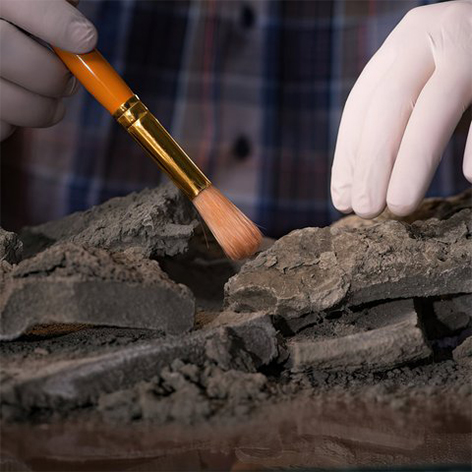
The Principles of Carbon-14 Dating
Radiocarbon analysis has been used across industries for decades to determine the age of various organic materials. Due to the half-life of 14C, the current limit of detection of the analysis is around 42K-50K years. Radiocarbon dating can be performed on organic material that at one point absorbed CO2 from the atmosphere, which can be achieved through a variety of pathways, such as photosynthesis or the creation of carbonates from dissolved atmospheric CO2.
14C concentration in a living entity remains constant throughout its life through continuous interaction and intake of atmospheric 14C. At the time of death, radiocarbon intake ceases, and the remaining 14C in the material undergoes radioactive decay. Without incoming 14C, the amount of radiocarbon decreases at the known rate for 14C. The remaining 14C at the time of analysis can then be used to determine the age of a sample.
Radiocarbon dating analysis via AMS involves three (3) main steps prior to AMS analysis. A sample typically goes through a pretreatment protocol, combustion or acid digestion, and reduction (graphitization).
Radiocarbon Dating Analysis Steps
pretreatment protocols
AAA
Acid/Alkali/Acid
Also known as ABA (Acid/Base/Acid), this pretreatment protocol is applied to most organic material types, such as charcoal, wood, peat, and plant. This is performed for the removal of carbonates by applying a hot HCl wash and the removal of humic acids through a NaOH wash. A final hot HCl wash is applied prior to rinsing the sample solution neutral, then dried to prepare for combustion.
Col-AAA
Collagen Extraction
This protocol is applied to bones. The sample surface is cleaned, then undergoes the AAA process and also extracting the protein component of the bone (collagen) through the removal of the mineral portion of the bone (calcium hydroxyapatite). The collagen extracted and pretreated is rinsed neutral and dried to prepare for combustion.
AO
Acid Only
This pretreatment protocol is typically applied to organic sediments. Sample is sieved, then a HCl wash is applied to remove any carbonates that may be present. The sample solution is then rinsed neutral and dried to prepare for combustion.
Carbonate Extraction
This protocol is applied to cremated bones. These bones have been heated to temperatures above 600°C and as a result, the bioapatite forms larger and better structure crystals that are typically not susceptible to contamination over time. After cleaning the external surface of the sample, it is treated with NaClO for 48 hours, then CH3COOH for 24 hours. The sample is then rinsed neutral and dried to prepare for acid digestion.
AE
Acid Etch
This pretreatment protocol is applied to most carbonates, such as shells and corals. Material is first rinsed with water to remove any debris if present, then exposed to a HCl wash. The sample solution is then rinsed neutral and dried to prepare for acid digestion.
*With all pretreatment protocols, acid and base exposure time, concentrations, and temperature will vary depending on the sample as each sample is unique.
*We offer additional pretreatment options from the ones listed. Please contact us if interested in other pretreatment protocols.
Combustion
Combustion
Organic Samples go through the combustion process after pretreatment. This involves placing some of the pretreated material in an evacuated quartz tube with excess CuO. The amount of the material added is dependent on availability and presumed carbon content based on material type. The evacuated tube containing the sample and CuO is then exposed to 800°C for two hours to drive the reaction. An unbalanced summary of the combustion reaction is as follows, where CxHy is the sample, and CuO is the oxygen source:
CxHy + CuO 800̊ C CO2 + H2O
Acid Digestion
Carbonate Samples go through the acid digestion process after pretreatment. This involves crushing some of the pretreated material, then placing it in a tube that is subsequently evacuated. The acid digestion is then started by adding H3PO4 to the sample in the vacuum environment. This reaction releases the carbon in the sample as CO2 gas. Similar to the CO2 gas created via combustion, this will be converted to graphite in the reduction (graphitization) step.
XCO3 + H3PO4 800̊ C CO2 + H2O + XPO4
XCO3 + H3PO4 800̊ C CO2 + H2O + XPO4
Reduction
(Graphitization)
The evolved CO2 via combustion or acid digestion is distilled through a cold (-78˚C) solid CO2/C3H8O slush to remove water as it is transferred under a vacuum to a reduction reaction vessel by a cryogenic pump using liquid N2 (-196°C). The reduction reaction vessel contains Co as the catalyst, and Mg(ClO4)2 as a drying agent. Hydrogen gas is added to the reduction reaction vessel and then heat is introduced (550°C) to drive the reaction. An unbalanced summary of the 2-step reduction reaction is as follows:
CO2 + H2 550̊ C, Co CO + H2O
CO2 + H2 550̊ C, Co C(graphite) + H2O
The graphite generated is pressed in Al cathodes and analyzed via AMS for radiocarbon dating.


